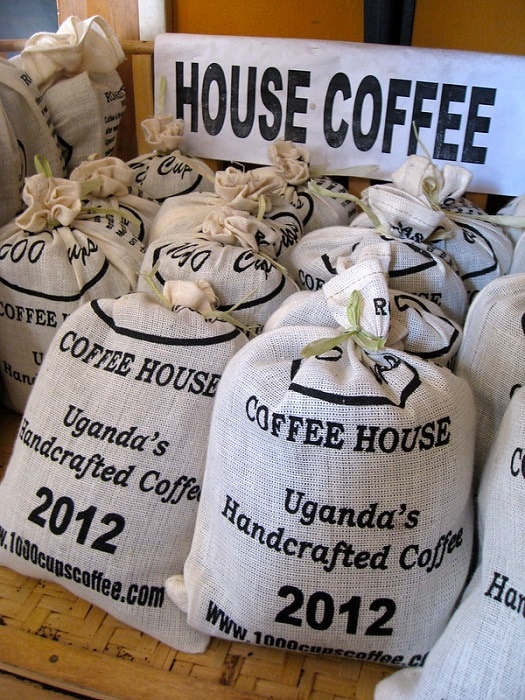
Uganda is not as well-known for coffee as some other coffee-producing African countries like Kenya and Ethiopia. Still, it has a long coffee history and has been gaining popularity recently. Despite being overshadowed by its continental siblings, coffee is the number one Ugandan export, and the coffee industry employs approximately 8% of the population.
In this article, we will give you an overview of the history and culture surrounding Ugandan coffee and point you in the right direction if you want to try some for yourself.
History of Coffee in Uganda
Coffee has been an important crop for Uganda’s economy for many decades. Historically, most coffee produced in Uganda has been Robusta rather than Arabica. Robusta coffee is naturally occurring in Uganda, which accounts for its lasting popularity among Ugandan farmers. Robusta also offers several advantages over Arabica and yields more exportable products per area used for farmland. It is also more resilient to disease and adverse weather conditions, giving Robusta a significant advantage over Arabica in production costs and yield.
However, Arabica coffee is widely regarded as a better varietal due to its lower bitterness and milder taste. The specialty coffee industry as a whole is dominated by Arabica coffee for this reason, and, recently, Ugandan coffee production has increased the focus on Arabica production.

Arabica coffee was initially introduced to Uganda from Ethiopia, where it grows naturally. Since Arabica coffee is not as robust – if you will – to adverse conditions as Robusta, it was thought that growing Arabica at a production scale in Uganda was infeasible. However, there are regions of eastern and western Uganda that have the necessary altitude and soil quality to cultivate Arabica plants successfully. Central Uganda is still dominated by Robusta farming due to the low altitude and warmer climate, which aren’t ideal for growing Arabica.
Transitional Difficulties
In the 1980s, the Ugandan coffee industry experienced only marginal gains compared to the worldwide boom in coffee demand and the rising prices that followed. Uganda was a member of the International Coffee Organization, a group of coffee-producing countries that set coffee prices and quotas for its members in an attempt to regulate coffee production fairly and consistently.
When coffee prices soared, prices and quotas were increased, but Uganda’s quota increase was restricted to Arabica coffee. Uganda’s coffee production was almost entirely Robusta at that time, and its capacity to produce Arabica was limited. As a result, Uganda coffee producers couldn’t take advantage of the increased quota and didn’t benefit as much as other countries that were better equipped to meet their quota.

Overcoming Setbacks
In the early 2000s, Ugandan coffee exports suffered from a global decrease in coffee demand and a subsequent decrease in prices worldwide. In an unfortunate coincidence, Uganda specifically was battling a fungal disease that resulted in the deaths of 45% of the country’s Robusta producing trees.
Despite these setbacks, coffee remains Uganda’s primary export and an important pillar that supports the Ugandan economy. Additionally, a new perspective and direction have given Ugandan coffee a bright future.
A Change of Approach: Ugandan Coffee Processing
In the last decade, coffee production in Uganda has changed its focus to embrace the more popular and lucrative Arabica varietal, and also the less traditional but more sought-after wash processed coffee.

After harvesting, coffee beans need to be dried before they can be packaged and exported. Traditionally, coffee was left to dry with some of the plant matter or mucilage intact. Coffee treated this way is said to be “naturally processed” and is the way coffee was processed until the alternative “washed processing” gained favor.
Wash processed coffee removes as much of the mucilage as possible before the coffee is dried. Coffee aficionados prefer washed processing because it gives a better representation of a coffee’s natural flavor. In contrast, naturally processed coffee is sweeter due to the longer interaction of the coffee bean with the surrounding plant matter and associated sugar, masking the bean’s innate characteristics.
Ugandan coffee is still largely naturally processed, but there has been a recent movement to export more wash processed coffee in an attempt to appeal to the growing audience that demands higher-quality coffee. Washed processing combined with increased Arabica cultivation has resulted in growth for the Ugandan coffee industry.
Trying it Yourself
If you want to try Ugandan coffee, we recommend buying both a traditional naturally processed Robusta and a modern washed Arabica if you can. Trying both side-by-side is an excellent way to compare and contrast and also get a view of the evolution of coffee in Uganda.
A fun experiment is to prepare both types of coffee using two different brewing methods. We prefer French press for naturally processed Robusta coffee and pour-over for wash-processed Arabica. Brewing both coffees with both methods is an interesting way to gain an appreciation for the interplay between the brewing method and coffee.
Conclusion
Ugandan coffee is often overlooked in favor of more established African coffee from Kenya, Ethiopia, and Tanzania. In recent years, Uganda has been steadily closing the gap in quality and notoriety between its coffee and other more popular coffee origins. This is largely because of a change in approach, shifting focus away from the traditionally dominating Robusta variety and instead embracing Arabica.
We recommend trying both a traditional Robusta variety and a modern Arabica if you can. Ugandan coffee offers a unique opportunity to sample different varieties sourced from the same region and compare and contrast how the processing and farming decisions impact how the coffee tastes in your mug.
RELATED READS:
- All About Haitian Coffee
- Madagascar Coffee: Everything You Need to Know
- What’s the Best Coffee Country in the World?
Featured Image: Per Bengtsson, Shutterstock














